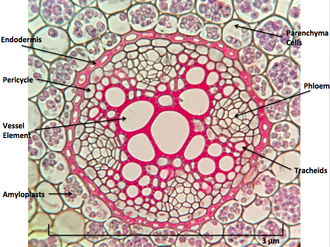Endodermis
Endodermis
The endodermis is a specialized layer of cells in the roots of vascular plants. It serves as a selective barrier that regulates the flow of water and nutrients from the soil into the plant's vascular system. The endodermis is a critical component of the plant's root anatomy, playing a key role in maintaining the plant's internal environment.
Structure
The endodermis is located between the cortex and the vascular cylinder (also known as the stele) of the root. It is typically a single layer of tightly packed cells that encircle the vascular tissues. The cells of the endodermis are characterized by the presence of the Casparian strip, a band of suberin and lignin that runs along the radial and transverse walls of the cells.
Casparian Strip
The Casparian strip is a hydrophobic barrier that prevents the passive flow of water and solutes into the vascular system. It forces water and dissolved substances to pass through the cell membranes of the endodermal cells, allowing the plant to selectively uptake nutrients and exclude harmful substances.
Function
The primary function of the endodermis is to regulate the movement of water and nutrients from the soil into the plant's vascular system. By forcing substances to pass through the cell membranes, the endodermis ensures that only essential nutrients are absorbed while harmful substances are excluded. This selective uptake is crucial for the plant's health and growth.
Development
The endodermis develops from the ground meristem, one of the three primary meristems in plants. As the root grows, the endodermal cells differentiate and develop the Casparian strip, which is essential for their function as a selective barrier.
Importance in Plant Physiology
The endodermis plays a vital role in maintaining the plant's internal environment by regulating the uptake of water and nutrients. It also helps in maintaining the root pressure, which is important for the upward movement of water and nutrients through the xylem.
Related Pages
Transform your life with W8MD's budget GLP-1 injections from $125.
W8MD offers a medical weight loss program to lose weight in Philadelphia. Our physician-supervised medical weight loss provides:
- Most insurances accepted or discounted self-pay rates. We will obtain insurance prior authorizations if needed.
- Generic GLP1 weight loss injections from $125 for the starting dose.
- Also offer prescription weight loss medications including Phentermine, Qsymia, Diethylpropion, Contrave etc.
NYC weight loss doctor appointments
Start your NYC weight loss journey today at our NYC medical weight loss and Philadelphia medical weight loss clinics.
- Call 718-946-5500 to lose weight in NYC or for medical weight loss in Philadelphia 215-676-2334.
- Tags:NYC medical weight loss, Philadelphia lose weight Zepbound NYC, Budget GLP1 weight loss injections, Wegovy Philadelphia, Wegovy NYC, Philadelphia medical weight loss, Brookly weight loss and Wegovy NYC
|
WikiMD's Wellness Encyclopedia |
| Let Food Be Thy Medicine Medicine Thy Food - Hippocrates |
Medical Disclaimer: WikiMD is not a substitute for professional medical advice. The information on WikiMD is provided as an information resource only, may be incorrect, outdated or misleading, and is not to be used or relied on for any diagnostic or treatment purposes. Please consult your health care provider before making any healthcare decisions or for guidance about a specific medical condition. WikiMD expressly disclaims responsibility, and shall have no liability, for any damages, loss, injury, or liability whatsoever suffered as a result of your reliance on the information contained in this site. By visiting this site you agree to the foregoing terms and conditions, which may from time to time be changed or supplemented by WikiMD. If you do not agree to the foregoing terms and conditions, you should not enter or use this site. See full disclaimer.
Credits:Most images are courtesy of Wikimedia commons, and templates, categories Wikipedia, licensed under CC BY SA or similar.
Contributors: Prab R. Tumpati, MD

